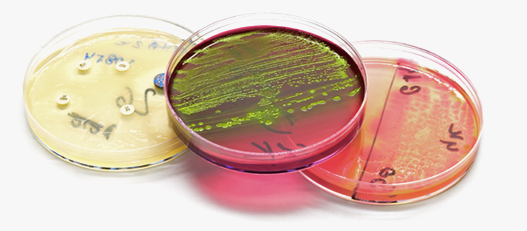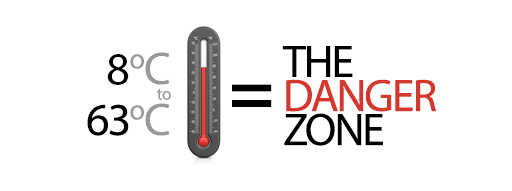Bacteria
There are thousands of different types of bacteria and many of them are useful bacteria. We need many of them to live.
A few are very harmful and some can cause food poisoning.
In this course we will talk about the 3 main types of bacteria.
Types of bacteria
Helpful bacteria - Allows us to:
- Digest the food we eat
- Produce food including yoghurt, cheese and fizzy drinks
Spoilage bacteria - A good example of this is the green mould you will see on bread that is a few days old. Never destroy just the slice with mould and use the rest. You must destroy the whole loaf.
Pathogenic bacteria - This is the name for bacteria that can transmit illness such as, food poisoning and foodborne disease.
Pathogenic bacteria are invisible to the naked eye.

You cannot see, taste or smell them which make them particularly difficult to control.
How does bacterial contamination occur?
Cross contamination is a major cause of bacterial contamination.
This is when pathogenic bacteria are transferred from raw foods to cooked foods.
It can happen:
- If you touch raw food and then touch a high-risk food without first washing your hands.
- When liquid or juices from raw food come into contact with high-risk foods, (defrosting a turkey above a cooked quiche).
- You do not clean a work area between handling raw and cooked foods.
One good way to help prevent cross contamination is to use colour-coded preparation equipment, such as chopping boards and knives.
Bacteria need help to move to another food, anything that helps bacteria to travel is called a 'vehicle of contamination'.
People, animals, equipment and utensils are the most common vehicles of contamination.
Bacteria need 4 factors in place to multiply rapidly:
What to do...
To prevent bacteria multiplying to a dangerous level we need to:
- Minimise the time high-risk food spends in the Danger Zone
- Chill and use high-risk foods according to the manufacturer’s instructions
- Cook and reheat following your approved processes
- Serve, cool and refrigerate, or hot hold food promptly
If you stop or remove one of the 4 requirements you will stop the growth of bacteria.
Bacteria and the Danger Zone

The key to safe food is to ensure that the time taken from preparation - cooking - serving is kept to a minimum
- Ideally prepare the food within 30 minutes (if not, put it back in the fridge)
- Cook the food for 2 minutes at 75°C (to the centre or thickest part)
- Serve the food within 20 minutes (or hot-hold at above 63°C)
Do not keep food in the Danger Zone any longer than necessary
Keep hot food really hot and cold food really cold
High-risk foods
These are foods that are normally high in protein and moisture and can easily allow bacterial multiplication.
Many high-risk foods are ready-to-eat and as a result they may not be cooked before serving. If you cannot cook them, you cannot destroy any bacteria that may be present.
As a result, you must only leave these food types in the Danger Zone for the shortest amount of time possible and only take out of the fridge or freezer when you are going to use them.
Examples of high-risk foods are:
- Cooked meat & poultry
- Pates, savoury spreads, gravy, stews, meat pies, stock
- Milk, cream, custards, cakes with cream, ice cream, dairy products
- Soft cheese
- Egg based products, mayonnaise, mousse, quiches
- Shellfish, mussels, oysters
- Cooked rice and pasta
Remember that chilled and frozen storage slows down bacterial multiplication and the time from preparation to service is critical.
Low-risk foods
By removing moisture, (with sugar or salt), or by using a vinegar, (pickle), you are effectively taking away one of the four main elements that bacteria need to survive.
It is rare for these foods to be associated with food poisoning outbreaks.
Examples of low-risk foods are:
- Jam, biscuits, dried foods, cereal, dried pasta, dried rice, flour, crisps, canned foods.
Once you have added water, moisture, bacterial multiplication will resume.
The Danger Zone is 5°C to 63°C
Learning outcomes
By the end of this chapter, you should have developed the following understanding and insights:
- An awareness of the terms helpful, spoilage and pathogenic bacteria
- An awareness of the fact that you cannot see, taste or smell the presence of bacteria
- An understanding of the main requirements bacteria need to multiply
- An awareness of the terms high-risk and low-risk foods